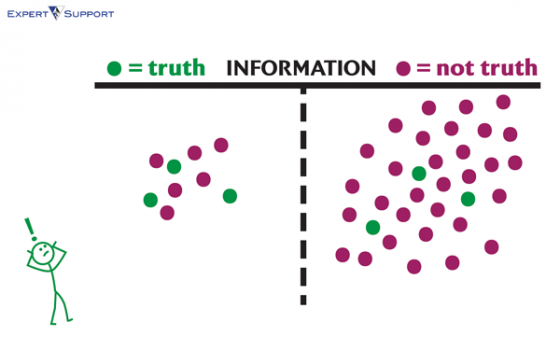Our last post described the information overload challenge and how technical writers can help overcome it. Deciding what information is most relevant to the task at hand, and then presenting it in a straightforward way is at the heart of the technical communications field.
But beyond the confines of technical communications, our society has a much harder problem to solve. In today’s world, not only is there much more information available than ever before, much of the information is fabricated, slanted, or both.
We need something to help us focus on the good information and discard the bad. Productive dialogue (also known as problem solving) is impossible to facilitate when stakeholders can’t even agree on the data underpinning the discussion, and their own data is undermined or politicized. While disinformation has always been part of the geopolitical landscape, it seems to be reaching new, epic heights in our digital age.
But, as always, there’s reason for hope!

Earlier this year, we attended the Silicon Valley launch of The Trust Project, an innovative organization with a pragmatic approach to address this problem. The organization was conceived when an accomplished journalist, Sally Lehrman, discovered that most young people just don’t trust the news anymore.
And yes, that’s ANY news. They’re tuning it ALL out.
As a citizen and journalist, Lehrman was alarmed enough to study the reasons behind this, and to use that data to inform exploration of potential solutions. In studying this issue, Lehrman and her colleagues discovered several elements of trust that they call trust indicators. These trust indicators help facilitate readers’ trust in news organizations.
Trust indicators reflect the common behaviors of reputable news organizations. Examples of trust indicators include disclosing the editorial mission of the organization, clarifying ownership, identifying members of the editorial board, publishing bylines with contact information for writers and editors, quoting verifiable sources, source attribution, and so forth.
The Trust Project is partnering with schema.org to define standard data structures for trust indicators, and asking serious news organizations to adopt and publish trust indicator data alongside the rest of their news content. Search engines like Google and Microsoft (which are helping to fund the effort) expect to use this data to prioritize more trustworthy news organizations in search results, and help mitigate the ill effects of poorly behaving fake news publishers. I can imagine social networks like Twitter and Facebook using these same mechanisms to encourage better behavior by publishers, too.
Housed at the Markkula Center for Applied Ethics at Santa Clara University, The Trust Project is taking a rational approach to solving a vexing problem that threatens the fabric of our society. We’re excited about the promise of The Trust Project, and look forward to a day when it’s easier for all of us to be well-informed without being misled.
One of our writers recently observed that as technical writers, our mission is to seek, understand, and explain the truth. Those efforts are sometimes complicated by hidden agendas. In those situations, effective technical communications can act as a change agent, and help an entire organization constructively focus on the truth. Doing so elevates corporate culture in meaningful, lasting, positive ways.
Have you experienced how effective technical communications can elevate culture? Or are you currently in a situation where change is needed? Either way, I look forward to hearing from you.
And I invite you to sign up for our email list so we can let you know about important posts and updates.
